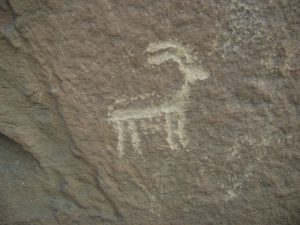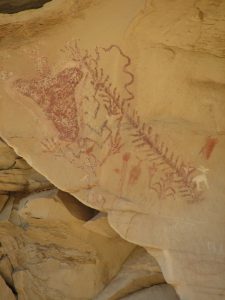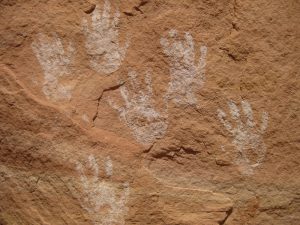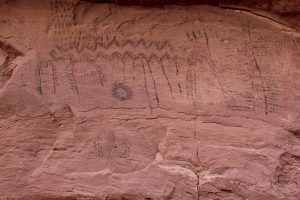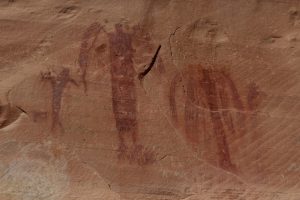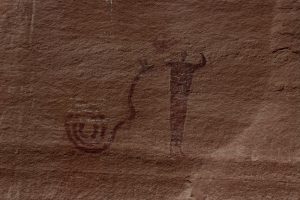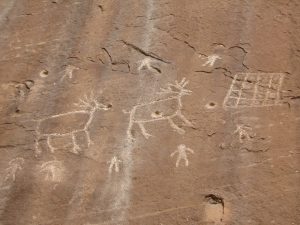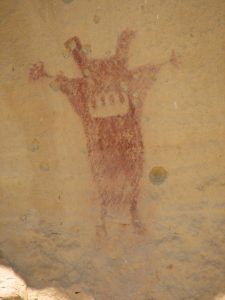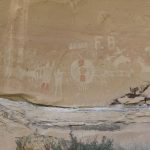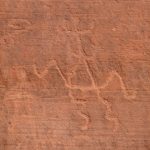
Rock art is one of man’s oldest forms of communication and one of the most universal. Rock art can be found on every continent except for Antarctica and some rock art sites in Europe have been dated as far back as 30,000 years old. By studying the images that our ancestors have left behind, we can get a fascinating and intimate glimpse into our past. The carved and painted images, both very old and very recent, show us what was important, what everyday life was like, and can draw a clear line to how we live our lives today.
The Colorado Plateau is one of the greatest places in the entire world to see and study rock art. The abundance of sandstone cliffs has created thousands of ideal canvases for petroglyphs and rock overhangs have protected painted images for thousands of years. Over 10,000 years of cultural habitation and contemporary Native American groups such as the Navajo and Ute have left thousands of images, making the region an intriguing mix of different ages and styles.
Yet for all that rock art can teach us, it leaves us with many more unanswered questions. In this exhibit we will look at not only some stunning examples of rock art found on the Colorado Plateau but also explore the cultures that made them. By combining the physical remains and images that each culture left we may be better able to understand what life was like many generations ago and today.
Rock Art Styles
Each time period, each region, and each culture has a unique way to draw figures. There are many different styles that archaeologists have cataloged that have slight twists and variations of their own. However, some common themes are found in each style. Rock art images can easily be broken into four different groups:
Abstract: Abstract images depict things that do not obviously occur in nature. Spirals, wavy lines, circles with spokes, and geometric shapes are all examples of abstract images. Each image probably had a meaning and purpose to their creators. However, this meaning is not completely clear to archaeologists today.
Click photos to enlarge.
Representational: Images that clearly depict something found in nature are representational. Animals, people, footprints, and plants can be clearly identified and are classified as representational. Some have stylistic enhancements or embellishments made to figures but as long as they can be identified in nature, they are called representational.
Click photos to enlarge.
Anthropomorphs: If an image has human-like qualities such as a torso, head, arms or legs it is an anthropomorph. Some anthropomorphs are very representational with eyes, mouths, headdresses, and jewelry while others are very abstract with elongated torsos or disproportionate limbs.
Click photos to enlarge.
Zoomorphs: Images that have animal-like qualities are zoomorphs. Like anthropomorphs, zoomorphs can be very realistic or very abstract. Lizards, birds, and sheep are very common on the Colorado Plateau.
Click photos to enlarge.
How is Rock Art Made?
There are several different ways to create rock art. Petroglyphs and pictographs are the two most common types found on the Colorado Plateau. Petroforms, the arrangement of rocks on the ground to create shapes, and geoglyphs, extremely large images carved into the Earth’s surface, are two rare styles.
Petroglyphs are the most common form of rock art. Images are created by pecking and carving into rock by striking the surface with a hard rock and hammerstone. Petroglyphs are commonly found on sandstone cliffs that have a high amount of dark staining known as desert varnish. When an image is carved into the dark patina the image will have the same light color of the native rock which creates high contrast that is easy to see.
Click photos to enlarge.
Pictographs are images that are painted onto rocks. The pigmentation generally comes from ground minerals and a binding agent such as animal blood or fat or sap is used to hold the paint to the rock surface. Different minerals create different colors and fascinating information can be found by examining what minerals were used on a panel and where the nearest supply of that mineral can be found. Pictographs tend to be found under rock overhangs or caves which have protected the images from the weather.
Click photos to enlarge.
Occasionally both pictographs and petroglyphs are combined to create one image.
Archaic (5000 BCE – CE 500)
Man has been in the American Southwest for over 10,000 years. The earliest time, what archaeologists refer to as the Paleo-Indian Era, was a time of massive animals called megafauna such as mastodons and mammoths. Bands of people hunted these giant game animals and the large spear and projectile points they used are one of the chief ways of dating a site as Paleo-Indian. The people of the Paleo-Indian Era were constantly on the move practicing hunter-gatherer subsistence. There is no definitive Paleo-Indian rock art on the Colorado Plateau.
Around 5000 BCE to CE 500 (5,000 years ago to 1,500 years ago). The Archaic covered such a large amount of time and space that several different Archaic rock art styles have been identified. Generally, Archaic rock art has many abstract-geometric shapes and very realistic anthropomorphs.
Archaic Styles
Glen Canyon Style –1000 BCE to CE 500
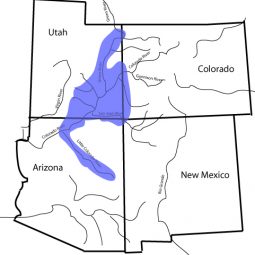
Glen Canyon Style is often found along rivers, possibly indicating the style was a result of sharing ideas. In addition, this style is often found in association with other styles on the same panel.
Common features include large anthropomorphs and zoomorphs whose bodies are rectangular or oblong and are internally decorated with cross-hatching. Heads and arms are generally small and figures appear to be stiff and lifeless. Very elaborate headdress and “rake” figures are also common.
Click photos to enlarge.
Barrier Canyon Style –1000 BCE to CE 500
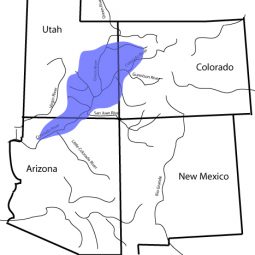 Barrier Canyon Style rock art spans from the Grand Canyon, across eastern Utah, and into northern Colorado. Generally, the style is painted but when pecked it tends to be in solid forms. The biggest indicator of Barrier Canyon is a supernatural feel. Anthropomorphs have broad shoulders and tapering bodies but details such as jewelry tend to be missing. Snakes are very common as are figures with large, hollow eyes.
Barrier Canyon Style rock art spans from the Grand Canyon, across eastern Utah, and into northern Colorado. Generally, the style is painted but when pecked it tends to be in solid forms. The biggest indicator of Barrier Canyon is a supernatural feel. Anthropomorphs have broad shoulders and tapering bodies but details such as jewelry tend to be missing. Snakes are very common as are figures with large, hollow eyes.
Click photos to enlarge.
Interior Line Style – CE 1 –1000
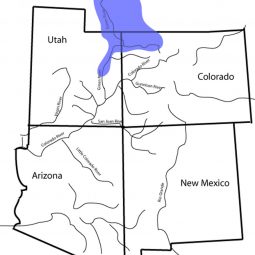 Interior Line Style is very similar to Glen Canyon Style and occasionally occurs on the same panels making it difficult to distinguish, although Interior Line is much younger. Images can be pecked or painted, generally in red. Human figures are more common and animals appear in long, horizontal rows. Wavy lines and dot patterns are also common. Like Barrier Canyon, artistic supernatural effects are found.
Interior Line Style is very similar to Glen Canyon Style and occasionally occurs on the same panels making it difficult to distinguish, although Interior Line is much younger. Images can be pecked or painted, generally in red. Human figures are more common and animals appear in long, horizontal rows. Wavy lines and dot patterns are also common. Like Barrier Canyon, artistic supernatural effects are found.
Click photos to enlarge.
Uncompahgre Style – 1000 BCE – CE 1000
 Uncompahgre Style rock art is very limited in distribution and is a unique style which adds evidence for a mountain culture that is separate from the Desert and Plain traditions that border the area.
Uncompahgre Style rock art is very limited in distribution and is a unique style which adds evidence for a mountain culture that is separate from the Desert and Plain traditions that border the area.
The style is almost always pecked and a panel will often have numerous images. Abstract and representational images appear side-by-side. Anthropomorphs tend to have stick bodies and individual fingers and toes.
Click photos to enlarge.
Fremont (CE 500- 1300)
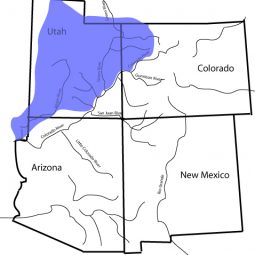 As the Archaic period came to a close (a time referred to as Basketmaker) a striking new element was being added to life on the Colorado Plateau: agriculture. Corn, beans, and squash were planted in the arid desert regions with greater efficiency and soon groups of people began staying in one place for extended periods of time to tend to crops. As larger groups began staying closer for longer and longer periods, they formed shared beliefs and ways of life. This marks the beginning of the Formative Era and the start of several distinct cultures on the Colorado Plateau including the Fremont, Ancestral Puebloan, Hohokam, and Mogollon.
As the Archaic period came to a close (a time referred to as Basketmaker) a striking new element was being added to life on the Colorado Plateau: agriculture. Corn, beans, and squash were planted in the arid desert regions with greater efficiency and soon groups of people began staying in one place for extended periods of time to tend to crops. As larger groups began staying closer for longer and longer periods, they formed shared beliefs and ways of life. This marks the beginning of the Formative Era and the start of several distinct cultures on the Colorado Plateau including the Fremont, Ancestral Puebloan, Hohokam, and Mogollon.
Around CE 500 a distinct culture now called the Fremont start to appear in Utah, western Colorado, and parts of Nevada and Idaho. The Fremont still heavily practiced hunter-gatherer practices but added agriculture into their lives. They started to form villages of pithouses (part subterranean round dwellings) and made very simple and utilitarian gray pottery. The Fremont are also noted for their Pilling figures and striking and detailed rock art.
Fremont rock art is found in most of Utah, northwest Colorado and into parts of Arizona, Utah, and Idaho. Anthropomorphs tend to have trapezoidal shaped bodies and some styles pay close attention to face markings, digits, and jewelry. Zoomorphs include snakes and big horn sheep with curving horns. “Shield” figures are also common which are anthropomorphs with large round bodies. Dots and spirals are found in abstract images.
Fremont Styles
Fremont rock art can be further broken into three distinct styles: Classic Vernal, Northern San Rafael, and Southern San Rafael.
Classic Vernal Style
Very large and lifelike anthropomorphs with elaborate headdresses, expressions, tears, necklaces, earrings, and digits.
Click photos to enlarge.
Northern San Rafael
Anthropomorphs are more simplified than Vernal or Southern styles and are often depicted in long lines or engaged in hunting and warfare. Body shapes are often not trapezoidal.
Click photos to enlarge.
Southern San Rafael
Trapezoidal shaped bodies but not as much detail as Vernal Style. Zoomorphs include sheep, snakes, centipedes and track ways.
Click photos to enlarge.
Ancestral Puebloan (CE 500 – 1300)
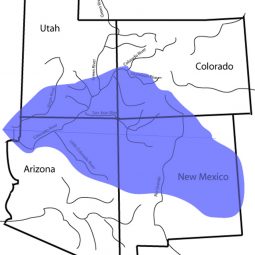
As the Fremont to the north were living a life of a mix of agriculture and hunter-gatherer, the Ancestral Puebloans (formally called Anasazi) of what is now the Four Corners region were developing massive architecture and large scale pueblos. Like the Fremont, they practiced irrigated farming but developed structures much larger than pithouses. Large masonry buildings and circular ceremonial and communal buildings called kivas were built and very ornate pottery with many different colors and shapes was created.
Ancestral Puebloan rock art is very difficult to describe in brief as the culture spread over such a vast distance and over a large range of time with each region having its own variation. However, there were some generalities and similarities. Handprints are common in all Ancestral Puebloan styles as are animal tracks and large quantities of zoomorphs. The flute player figure, commonly called Kokopelli, is featured and abstract symbols are carefully created. Details in animals are vivid and both petroglyphs and pictographs are used.
Click photos to enlarge.
Several Ancestral Puebloan sites are well noted for archaeo-astronomy connections. Fajada Butte in Chaco Canyon has two petroglyph spirals that are positioned under three boulders. As the sun moves across the horizon during the year, the boulders create shadows and shafts of light. The equinox as well as summer and winter solstices can be marked and tracked by the daggers of light that hit the spirals. Also, at Mesa Verde, a pictograph appears to chart the movement of the moon on the western horizon.
The Ute (CE 1600 – Present)
 A great drought struck the American Southwest beginning in the 1270s. Many Fremont and Ancestral Puebloan sites were abandoned and direct linage of those cultures becomes difficult to follow. Many theories have been put forward about why the cultures left. The great drought, raiders from other cultures, and merging with other groups in new locations have all be proposed.
A great drought struck the American Southwest beginning in the 1270s. Many Fremont and Ancestral Puebloan sites were abandoned and direct linage of those cultures becomes difficult to follow. Many theories have been put forward about why the cultures left. The great drought, raiders from other cultures, and merging with other groups in new locations have all be proposed.
Around this time, a new group was making its way into the Southwest. Numic speakers (later to be divided into the Paiute, Shoshone, and Ute tribes) made their way into the Great Basin region around 1000 CE. Archaeologists have found perhaps the first evidence of Utes in Colorado dating to approximately 1100. Unlike the Fremont or Ancestral Puebloan before them, the Utes preferred to live in structures made of branches that were leaned against each other in a cone shape called wickiups. The Utes were also excellent hunters with animal bones from elk, rabbit, deer, and even bison found at historic Ute sites.
The Spanish recorded meeting the Utes in 1626 and made note that they were the only aboriginal inhabitants of the region at the time. The Spanish also introduced the Utes to horses which would greatly expand the Ute hunting territory. Ute pottery tended to be rather simple in decoration but unique in having a wide mouth and pointed base.
Ute rock art in the earliest years is very difficult to separate from other rock art styles but by 1600 unique characteristics can be seen. Early Ute rock art (pre-European contact) depicts men with shields and spears. Late rock art is most easily identified by men on horseback and details on clothing and weapons and modern tools. Bears are also very common in Ute rock art as either the entire animal or bear paws. These symbols can be exaggerated, perhaps in an attempt to make them look more powerful or spiritual.
Click photos to enlarge.
While archaeologists can only ask suspected ancestors of the Fremont and Ancestral Puebloan about the meaning of those culture’s rock art, the Ute are still with us today to offer insight.
The Navajo (CE 1500 – Present)

Like the Numic speakers, the Athapaskan speaking Navajos appeared in the Great Basin area around 1400 CE. By 1640 the Navajo arrived in northern New Mexico and migrated into the San Juan River drainage around 1700. This first phase of Navajo history is known as the Dinetah Phase and is marked by the use of hogans traditionally used as dwellings, plain gray pottery, and mainly hunter-gathering with corn and beans as crops later in the phase. Religion was also heavily influenced by the modern Puebloan cultures. After 1700 the Navajo entered the Gobenador Phase marked by an increase in sheep herding and more elaborate pottery.
Click photos to enlarge.
As with Ute rock art, one major way to determine Archaic from Navajo style is to look for modern clues such as horses, guns, and Europeans. Rock art from the Gobenador Phase (1700-1775) is noted for modern references as well as a spiritual nature. Modern Puebloan influence can be seen in the rock art from this time as well. Masked dancers, much like the kachina religion that was forming elsewhere, are common as are deities specific to Navajo religion. Pictographs and petroglyphs are often combined and older images are stamped out. Corn and animals are also common. Later Navajo rock art has many horses and depictions of everyday life.
Rock Art Preservation
While some rock art images on the Colorado Plateau have lasted 3,000 years, this valuable and spiritual resource is in danger. It is now rare to come across a rock art panel that has not been vandalized by graffiti, bullet holes, or have elements completely removed. Please, do your part to protect these cultural treasures.
Click photos to enlarge.
Visit rock art sites with respect. Many cultures today see rock art as being just as sacred as it was when it was created.
Do not touch images. The oils on your hands cause damage that cannot be fixed.
Take only pictures. Paper rubbing and latex molds cause irreversible damage.
Respect private property rights.
Leave archaeological clues found near rock art panels in place. Artifacts such as projectiles can help archaeologists better understand and date the age of panels.
Report any vandalism to a local land agency such as the Bureau of Land Management, Forest Service, Park Service, or call 1-800-VANDALS















